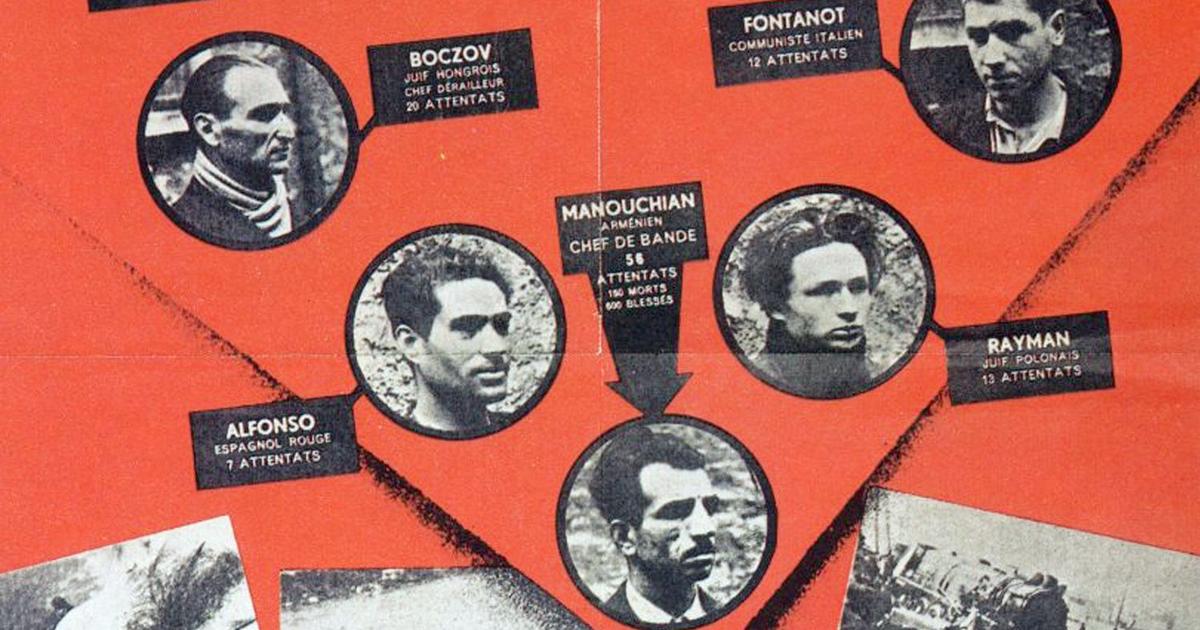“Manouchian. Armenian. Gang leader. 56 attacks. 150 dead. 600 injured
.
From February 18 to 24, 1944, the emaciated face of Missak Manouchian was plastered on a red background in 15,000 copies, in several towns and villages in France.
Next to him, nine other names and photos:
“Boczov.
Hungarian Jew.
Chief derailleurs.
20 attacks”
,
“Fontanot.
Italian communist.
12 attacks”
, or even
“Alfonso.
Red Spanish.
7 attacks
.
And this mention, written in white:
“Liberators?
Liberation from crime by the army
.
The poster was printed in 15,000 copies and displayed in several cities in France.
AFP
The day before this large-scale poster campaign, the ten men were all sentenced to death by the Nazi occupation regime, along with 12 others and one woman.
On February 21, the 22 men were shot at Mont-Valérien.
The woman, Olga Bancic, will be beheaded in Germany on May 10.
They were all part of the communist resistance network
“Francs-tireurs et partisans – immigrant workforce”
(FTP-MOI), and more precisely of what Nazi propaganda nicknamed the
“Manouchian Group”
, after the name of their leader. , who will enter the Pantheon on Wednesday February 21, 80 years after his death.
Also read: Missak and Mélinée Manouchian at the Panthéon: the Élysée wants to honor the “preferably French”
Playing on fear, anti-Semitism and xenophobia
At that time, the faction was accused by the regime of multiple executions, attacks and sabotage actions against the collaborationists and occupiers.
In particular, she ensured the execution of General Julius Ritter, Fritz Sauckel's deputy for France, responsible for labor mobilization (STO), who requisitioned against their will and transferred hundreds of thousands to Germany of French workers to contribute to the war effort.
The
“Manouchian group”
was also behind around thirty operations in Paris between August and November 1943.
When the Vichy administration arrested Missak Manouchian and most of her group, it wanted to take the opportunity to discredit the FTP-MOI in the eyes of the French population.
To do this, it set up a vast propaganda campaign with the German occupiers, including the famous red poster, which did not hesitate to play on the psychological roots of fear and xenophobia.
Red thus represents the color of blood and that of communism.
The faces of the ten resistance fighters are gathered in a triangle of the same color, which points to photos of derailed trains, vast arsenals and bodies riddled with bullets.
Their acts of resistance are thus assimilated to organized crime and therefore to purely criminal operations.
Also read: Manouchian, the Armenian resistance fighter who was at the heart of a war of memories
The condemned are further reduced to their last name, their nationality and, for the most part, their Jewishness.
The message is unequivocal: foreigners, Jews and communists in France engage in criminal activities while claiming to act for the liberation of the country.
The anti-Semitic and xenophobic aim of this propaganda campaign is even clearer on the leaflets distributed alongside the posters.
In particular, we can read this message:
“Here is the proof, if the French pillage, steal, sabotage and kill, it is always foreigners who command them (...), it is always the Jews who inspire them”
.
Or again:
“Banditry is not the expression of wounded patriotism (...), it is the global dream of Jewish sadism”
.
A failed influence?
It is difficult
in hindsight
to assess the effectiveness and exact impact of this campaign on the French population.
However, many expressions of sympathy were recorded at the time.
Several anonymous hands placed flowers at the foot of the posters, or stuck banners on which various messages were written such as:
“Martyrs”
,
“Dead for France”
or even
“Yes!
The Resistance Army
.
“On the emaciated faces of the martyrs, passers-by undoubtedly read above all the tortures suffered”
during their incarceration, underlines the Museum of the History of Immigration, in a note aimed at presenting an exhibition dedicated to the
“Red Poster »
.
The “army of crime”
denounced by the propaganda of the Vichy regime undoubtedly did not horrify a population, which nevertheless suffered from the actions of the resistance.
“If this poster aroused hatred, it was against the executioners, and not against these patriots from elsewhere
,” summarizes the museum.
In the second volume of her autobiography,
The Force of Age
, Simone de Beauvoir shared her feelings:
“Despite the crudeness of the clichés, all these faces that were offered to our hatred were moving and even beautiful;
I looked at them for a long time, under the arches of the metro, thinking with sadness that I would forget them.”
Read alsoManouchian at the Pantheon: “You have to be there”, retorts RN vice-president Louis Aliot to Emmanuel Macron
In the years following the Liberation, this
“Red Poster”
passed into posterity.
The poet Louis Aragon notably dedicated
his
Stanzas to remember to the 23 resistance fighters of the
“Manouchian group”
.
He wrote there:
“The poster which looked like a stain of blood/Because pronouncing your names is difficult/It was looking for an effect of fear on passers-by…”
.
These few verses were then set to music by Léo Ferré, who in 1961 composed a minimalist melody, simply punctuated by a drum roll, intended to highlight the sacrifice of these men who had not “claimed
glory, neither tears nor the organ, nor prayer to the dying
.

